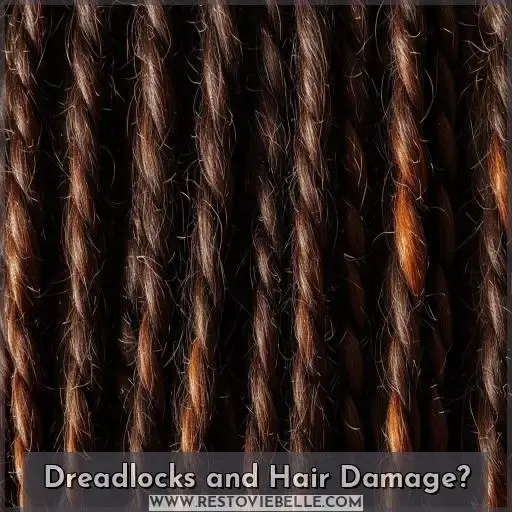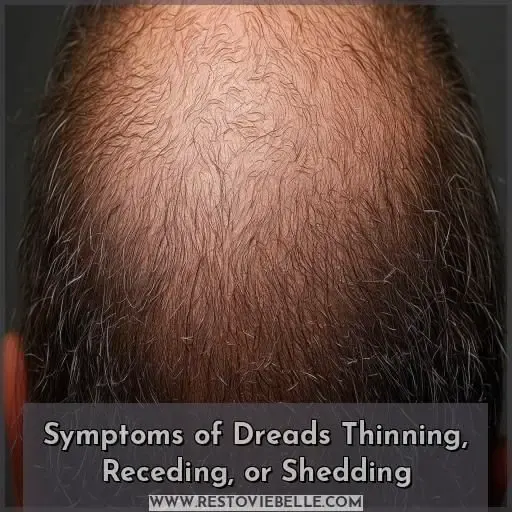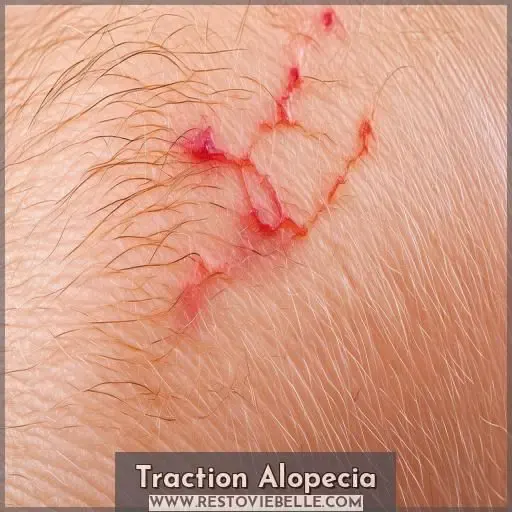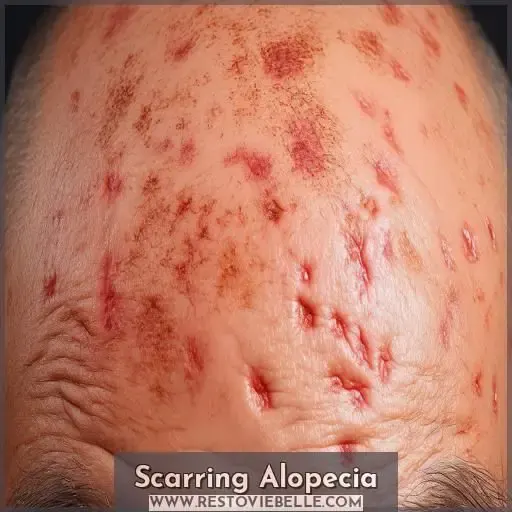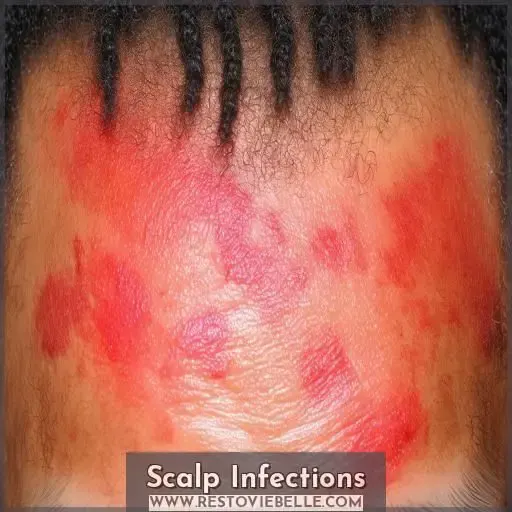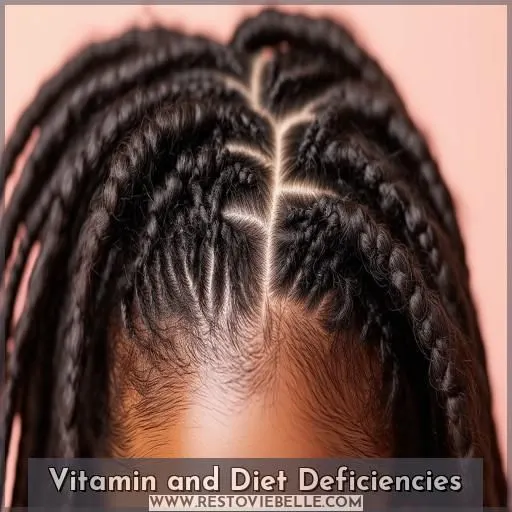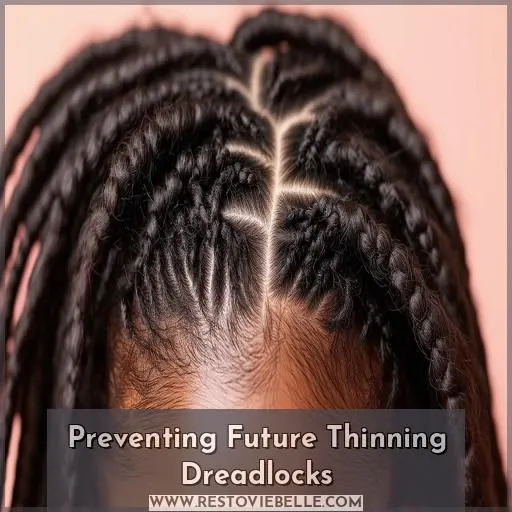This site is supported by our readers. We may earn a commission, at no cost to you, if you purchase through links.
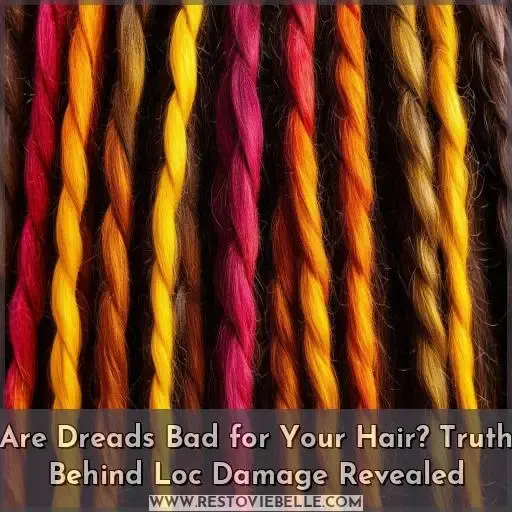 The truth is, dreadlocks aren’t inherently damaging. However, maintaining them requires balance.
The truth is, dreadlocks aren’t inherently damaging. However, maintaining them requires balance.
Excessive tension from tight twisting or the weight of thick, long locs can lead to traction alopecia – gradual hair loss from follicle strain.
Poor hygiene causing scalp infections like seborrheic dermatitis can impede growth too.
With proper dread maintenance, including loose styling and quality loc products, you can rock this protective ‘do without compromising your hair’s health.
But keep an eye out for thinning or shedding – that’s your cue to reassess your regimen before more serious issues arise.
Table Of Contents
- Key Takeaways
- Are Dreads Bad for Your Hair?
- Dreadlocks and Hair Damage?
- Symptoms of Dreads Thinning, Receding, or Shedding
- Traction Alopecia
- Scarring Alopecia
- Scalp Infections
- Vitamin and Diet Deficiencies
- Preventing Future Thinning Dreadlocks
- Frequently Asked Questions (FAQs)
- Do dreadlocks mess up your hair?
- Are dreadlocks healthy for hair?
- What are the disadvantages of dreadlocks?
- Why shouldn’t you get locs?
- How long can dreadlocks typically last?
- Are dreadlocks suitable for all hair types?
- Whats the best way to detangle dreadlocks?
- How often should dreadlocks be retwisted?
- Can dreadlocks be styled or colored safely?
- Conclusion
Key Takeaways
- Dreadlocks aren’t inherently damaging, but they require a delicate balance of proper maintenance. It’s like walking a hair-raising tightrope act – one misstep, and your locks could tumble.
- Excessive tension from tight twisting, hefty loc weight, or poor hygiene can unleash the wrath of traction alopecia, scalp infections, and nutrient deficiencies – a hair horror story you don’t want starring your crown.
- However, with gentle styling, quality loc products, and a balanced regimen, you can confidently rock these free-spirited ropes without sacrificing your hair’s health. It’s all about respecting your strands’ needs.
- Stay vigilant for thinning, shedding, or dread rot creeping in. These hair-raising symptoms are your scalp’s cry for help. Listen closely, and revamp your routine before more serious damage ensues – because a happy scalp means thriving locs.
Are Dreads Bad for Your Hair?
No, dreadlocks aren’t inherently bad for your hair. However, improper dreadlock maintenance, such as excessive tension, tight styling, and lack of proper cleansing, can lead to hair damage, thinning, and even permanent hair loss.
Dreadlocks and Hair Damage?
You’ve heard the whispers: "Dreads are bad for your hair!" But is this true, or just another myth?
Dreadlocks, when cared for properly, are actually a protective hairstyle. They form naturally, with a spiral-like interior and matted exterior, shielding your hair from daily wear and tear.
However, over-maintenance can be your locs’ enemy. Excessive twisting can break follicles, leading to hair damage. And beware of dread rot—scalp mold from moisture buildup. Long, thick locs can also strain roots, causing thinning.
The key? Balance. Use all-natural products for dreadlock grooming, wash once or twice a week, and dry completely. Trim heavy locs to reduce strain.
Symptoms of Dreads Thinning, Receding, or Shedding
You might notice your dreads thinning, receding, or shedding due to traction alopecia affecting your hairline, scalp infections slowing hair growth, or stress-related factors causing loc shedding. These symptoms indicate potential loc damage, requiring immediate attention to prevent further hair loss and maintain the health of your dreadlocks.
Traction Alopecias Hairline Impact
You’ve embraced your locs, but now you’re noticing a receding hairline—the tragedy of traction. Traction alopecia, caused by tight styling, is pulling your hair out. Signs include:
- Thinning at the edges
- Soreness and itching
- Visible scalp near hairline
Don’t worry; you can still rock your dreads without sacrificing your hairline. Focus on hairline protection, scalp soothing, and nourishing hydration. Use organic dreadlock products and consult a dermatologist for personalized hair care advice.
Scalp Infections Slow Growth
Your locs’ health starts at the scalp.
Seborrheic dermatitis and scalp psoriasis aren’t just pesky—they’re loc growth’s nemesis. These scalp infections create an unwelcoming environment, slowing hair growth to a crawl.
Don’t let scaly patches and inflammation rule your crown. Proper locs care isn’t just about twists; it’s about nurturing your scalp.
Stress-Related Loc Shedding
Just like scalp infections, stress can wreak havoc on your dreads. Telogen effluvium, a stress-triggered condition, can make your locs thin out rapidly.
Life’s curveballs—childbirth, menopause, extreme weight loss—can shock your hair into a resting phase, causing clumps to fall out.
Don’t let stress pull the rug out from under your scalp! Proper nutrition and stress management are your allies in this battle for hair health.
Traction Alopecia
Your dreadlocks might be causing traction alopecia, a condition where repeated tension, tight twisting, and the weight of your locs lead to hair thinning and breakage. To prevent this, avoid pulling your hair too tightly when styling and consider trimming heavy locs to reduce strain on your roots.
Repeated Tension and Pulling
Your locs might be your crown, but repeated tension and pulling can turn that crown into a thinning mess.
Over-twisting or heavy, long dreadlocks can strain your roots, leading to breakage and hair thinning. Incorrect hair products only add fuel to the fire.
If you’re noticing scalp tenderness or inflammation, it’s a cry for help. Don’t ignore it!
Learn the dos and don’ts of loc care to repair and protect your regal mane.
Twisting Locs Tightly
You might think tight twisting is key to loc development, but it’s a silent culprit behind traction alopecia. Those snug styles you love can actually hinder hair growth and threaten your scalp health. Many wonder, "Are dreads bad for your hair?" Not inherently, but overzealous loc maintenance can lead to hair thinning. Here’s why:
- Tight styles strain follicles, causing inflammation and potential root damage.
- Excessive twisting disrupts natural hair growth cycles, leading to breakage.
- Constant tension from tight locs can weaken your hairline, resulting in recession.
Weight of Hair Causes Thinning
Beyond tight twisting, the sheer weight of your locs can lead to thinning—a classic sign of traction alopecia. It’s like your hair’s saying, "This is too heavy to handle!" Long, thick dreads strain your roots, causing gradual hair loss.
Don’t fret; understanding your hair’s limits is key. Balance loc weight with proper maintenance, nutrient-rich diets, and scalp health.
Are locs bad for your hair? Not if you respect its needs.
Scarring Alopecia
You might be at risk for Central Centrifugal Cicatricial Alopecia (CCCA), a type of scarring alopecia that starts at the crown and moves outward, severely damaging hair follicles. CCCA, which may have genetic links, replaces follicles with scar tissue, leading to thinning at the crown, itching, and discomfort.
Central Centrifugal Cicatricial Alopecia
Beyond traction alopecia, your locs might be battling another foe: Central Centrifugal Cicatricial Alopecia (CCCA).
It’s a genetic twist in your hair story, where your scalp’s discomfort signals a deeper issue. CCCA causes your hair follicles at the crown to be replaced by scar tissue.
Your genes might be playing a role in this alopecia adventure, turning your crown into a battlefield. Don’t worry; understanding is your first step toward liberation.
Hair Loss at Crown
You’re noticing your dreads thinning at the crown? It’s a sign of scarring alopecia, a condition that replaces hair follicles with scar tissue. This isn’t just a cosmetic issue; it’s a cry for help from your scalp. Consider:
- Chronic tension from heavy locs
- Lack of moisture leading to dryness
- Potential genetic predisposition
- Emotional impact on self-esteem
Don’t ignore these signs. Your crown’s health reflects your journey to freedom through self-expression. Let’s make sure your locs empower, not hinder, your path.
Genetic Links
Your scalp health and hair density might be genetically predisposed to Central Centrifugal Cicatricial Alopecia (CCCA). This condition can slow loc growth and cause loc breakage, starting at your crown and moving outward.
While dreadlocks are a protective hairstyle, they can’t shield you from genetic factors. It’s like playing a game with a stacked deck—but don’t fold yet!
Understanding your genetic hand can help you maintain healthy locs and a happy scalp.
Scalp Infections
You’re at risk of developing scalp infections like folliculitis, seborrheic dermatitis, or psoriasis when wearing dreadlocks. These conditions can lead to inflammation, scaling, and slow hair growth, potentially contributing to thinning locs or excessive shedding.
Folliculitis
Another scalp infection that can lead to locs thinning is folliculitis. You’ll notice inflammation and pus-filled bumps around hair follicles. Causes include bacteria, fungi, and ingrown hairs trapping sweat. Treat with antibiotics, but prevent future flare-ups by keeping locs clean, allowing air circulation, and avoiding tight hairstyles that trap moisture.
Seborrheic Dermatitis
You might also experience seborrheic dermatitis, an inflammatory scalp condition causing overproduction of sebum, leading to a scaly, oily scalp. This can slow hair growth and contribute to loc shedding. Proper cleansing, moisturizing, and using medicated shampoos can help manage scalp inflammation from seborrheic dermatitis.
Psoriasis
You might also experience psoriasis, causing scaly patches and inflammation. These irritated areas can lead to:
- Slow hair growth
- Hair thinning
- Excessive shedding
- Increased breakage
Proper treatment and care for scalp psoriasis is necessary for healthy dreadlocks. Consult a dermatologist for an effective management plan.
Vitamin and Diet Deficiencies
You may be experiencing dreadlock thinning, shedding or stunted growth due to vitamin and mineral deficiencies. A lack of essential nutrients like iron, zinc, B12, folic acid, and vitamins C, D, and E can impair hair follicle function and disrupt the hair growth cycle, leading to thinning dreadlocks over time.
Lack of Iron
Iron deficiency can stunt your locs’ growth and cause excessive shedding. If you’re not getting enough iron from your diet, consider adding iron-rich foods like spinach, lentils, and lean red meat. A simple blood test can check your iron levels, and vitamin supplements may help restore them.
| Iron Sources | Benefits |
|---|---|
| Spinach | Packed with iron, folate, vitamins A and C |
| Lentils | High in iron and protein |
| Red Meat | Excellent source of heme iron |
| Fortified Cereals | Non-heme iron added |
| Vitamin C | Aids iron absorption |
Lack of Zinc
You may also experience loc thinning or shedding due to a zinc deficiency. Zinc plays a vital role in hair growth and repair. Verify that you get adequate zinc intake through sources like oysters, beef, crab, and fortified cereals. If dietary zinc is lacking, consider a zinc supplementation to support healthy loc growth.
Lack of B12
A lack of B12 can lead to hair loss and poor hair growth. You may notice:
- Thinning locs
- Dull, brittle strands
- Slow regrowth after trims
B12 is essential for healthy red blood cells and DNA synthesis – vital for strong, vibrant locs. Eat foods like eggs, meat, and fortified cereals, or consider a B12 supplement if deficient.
Lack of Folic Acid
Like B12, you need folic acid for healthy hair growth and to prevent shedding. Folic acid deficiency disrupts your body’s cell production, leading to hair thinning and dull locks. Adding leafy greens, citrus fruits, beans, and fortified cereals to your diet boosts folic acid for stronger, more vibrant dreadlocks.
Lack of Vitamins C, D, E
Vitamin C, D, and E deficiencies can be hair-raising issues for your locs! Without these essential nutrients, your strands face stunted growth and shedding. C aids collagen production for strong roots; D boosts hair follicle renewal; E’s antioxidants shield strands. Load up on citrus, fatty fish, and nuts to keep those locs luscious and thriving.
Preventing Future Thinning Dreadlocks
Preventing future thinning of your dreadlocks is of utmost importance for their health and longevity. You must refrain from using petroleum-based products, hairstyles that strain your locks, and guarantee protection from friction by using silk or satin accessories; additionally, invest in professional hair coloring services and quality loc care from trained stylists to establish a solid foundation.
Avoid Petroleum Products
You’ll want to avoid petroleum products in your loc routine. They:
- Prevent loc formation
- Cause locs to disintegrate
- Slow the locking process
These products leave residue buildup, creating an environment ripe for potential mold growth. Plus, they lubricate locs, hindering knot tightening – the key to maintaining those gorgeous ropes.
Avoid Tight Styling
You put your locs at risk of traction alopecia and irreversible hairline damage when you opt for tight hairstyles. Intricate or root-straining styles excessively pull on your locs, leading to thinning edges and permanent hair loss around your hairline. Steer clear of severely tight updos which overstretch and weigh down your fragile locs.
Protect Locs With Silk or Satin
You’ve avoided petroleum products and tight styles, but to further protect your locs, invest in protective gear:
- Silk bonnets prevent friction and moisture loss
- Satin pillowcases reduce snagging and breakage
- Breathable fabrics allow hair to breathe
Using the right protective materials is essential for healthy, thriving locs. Embrace the freedom of wearing your crown confidently!
Professional Hair Coloring
You should visit professional colorists at a salon for color services on your locs. Over-processing with bleach or dye at home can severely damage and dry out hair follicles. Uneven color distribution is common when dyeing locs yourself. Trained stylists have the expertise to properly color locs while minimizing breakage.
Invest in Quality Loc Care
You’ve invested so much into your locs – don’t compromise with cheap installations or retwists. Untrained individuals may not provide the quality care your locs deserve. Start with a solid professional foundation to avoid issues down the line. Investing in quality loc care from experienced stylists guarantees your crown stays healthy and thriving.
Frequently Asked Questions (FAQs)
Do dreadlocks mess up your hair?
Dreadlocks can absolutely damage your hair if not properly maintained. Excessive twisting, bleaching, or heavy locs can strain roots, causing breakage and thinning. However, with the right techniques and products, dreadlocks can be a protective, low-maintenance style.
Are dreadlocks healthy for hair?
Dreadlocks can be healthy for your hair if done and maintained properly. However, improper locking techniques, tight styles, and using harsh products can seriously damage your strands and cause hair loss. Proper care and professional guidance is essential for keeping your dreadlocks and scalp in good condition.
What are the disadvantages of dreadlocks?
You may think dreadlocks symbolize freedom, but they’re not without downsides. Excessive twisting damages follicles, thick dreads strain roots causing hair loss, and mold can develop from moisture buildup – not so liberating after all.
Why shouldn’t you get locs?
You shouldn’t get locs if you’re unwilling to commit fully. Proper loc maintenance requires dedicated time and effort – neglecting them can lead to scalp issues, thinning, and irreversible damage. Be realistic about your lifestyle before taking the plunge.
How long can dreadlocks typically last?
Dreadlocks, those free-spirited symbols of nonconformity, can endure for years – a decade or longer with diligent care. A testament to patience, their lifeline depends on your dedication to nurturing these tangled tresses.
Are dreadlocks suitable for all hair types?
Dreadlocks can work for all hair types, but aren’t one-size-fits-all. Coily textures may loc more easily, while straight hair needs extra manipulation. Ultimately, healthy loc formation depends on your commitment to precise care and patience during the locking process.
Whats the best way to detangle dreadlocks?
Gently detangle dreadlocks from the ends, working upward with patience. Use residue-free oils or conditioning detanglers to loosen knots. Avoid excessive force, as hair breaks easily when locked. Take breaks and hydrate hair to prevent damage.
How often should dreadlocks be retwisted?
You should retwist dreadlocks every 4-8 weeks. Regular retwisting keeps locs tight, neat, and prevents slippage or unraveling. But be gentle – excessive tightening can damage hair follicles and cause traction alopecia.
Can dreadlocks be styled or colored safely?
Yes, dreadlocks can definitely be styled and colored safely with the right precautions. Let a professional handle any major changes to prevent damage and make sure your locs stay strong and healthy.
Conclusion
Though striking, are dreads bad for your hair? Not inherently, but proper maintenance is key. Monitor for traction alopecia, scalp infections, and nutritional deficiencies – address these promptly. With gentle styling, quality loc products, and a balanced regimen, you can confidently rock locs without compromising hair health. Heed your body’s signals to prevent irreversible damage.

